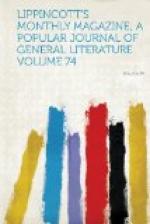OUR MONTHLY GOSSIP.
THE CABS OF PARIS.
Paris is without doubt, of all large cities, the easiest to get about in. Lines of omnibuses cross and recross its surface in every direction, and, better still, the streets swarm with cabs, in which for the small sum of thirty cents one can pass at will from any given point to any other far distant one within its limits. There are carriage-stands on every side and in every principal street, and unoccupied vehicles may be seen driven at a snail’s pace, with their drivers keenly on the lookout for a possible fare. Yet, with all this provision, it is occasionally very difficult to secure a carriage in Paris. On a sunny Sunday afternoon, on the day of the Grand Prix de Paris, or during the prevalence of a sudden storm carriages are as scarce in Paris as they are in New York. Yet their number increases daily, thanks to the law of 1866, by virtue of which any coachman who can pass an examination as to his knowledge of driving and acquaintance with the streets of Paris can, if he likes, purchase a vehicle of the regulation style, have his number painted on it and set up for himself as a public cabman, subject always in the matter of pace, charges, etc. to the police laws regulating all such details.
It has taken two hundred and thirty years to bring the cab-system of Paris to the point of perfection to which it has now attained. In 1617 the only public means of locomotion was afforded by a company which let out sedan-chairs. In 1640 a certain Nicholas Sauvage, agent for the stage-coaches of Amiens, formed the plan of establishing carriages, harnessed and ready for use at certain designated points, for the accommodation of the public. These vehicles were christened fiacres, but the reason for their receiving this appellation remains unknown. Some say it was because Sauvage occupied a house the facade of which was decorated with an image of St. Fiacre: another and more probable solution of the mystery has been found in the fact that just at that epoch a monk of the Petits Peres, called Fiacre, died in the odor of sanctity, and his portrait was placed in all the new vehicles to protect them against accidents. Be this as it may, the new enterprise proved successful, and in 1703 a law was passed compelling the numbering of all public carriages. In 1753 there existed in Paris twenty-eight cab-stands and sixty livery-stables, containing in all one hundred and seventy carriages. At present, Paris possesses over eight thousand cabs and three thousand livery-stable carriages: these last are generally very handsome vehicles, drawn by spirited, well-kept horses and driven by stylish-looking coachmen. The public vehicles of Paris, exclusive of the omnibuses, may be divided into three classes. First, the voitures de place, which are permitted, on payment of an annual tax of three hundred and sixty-five francs, to stand




